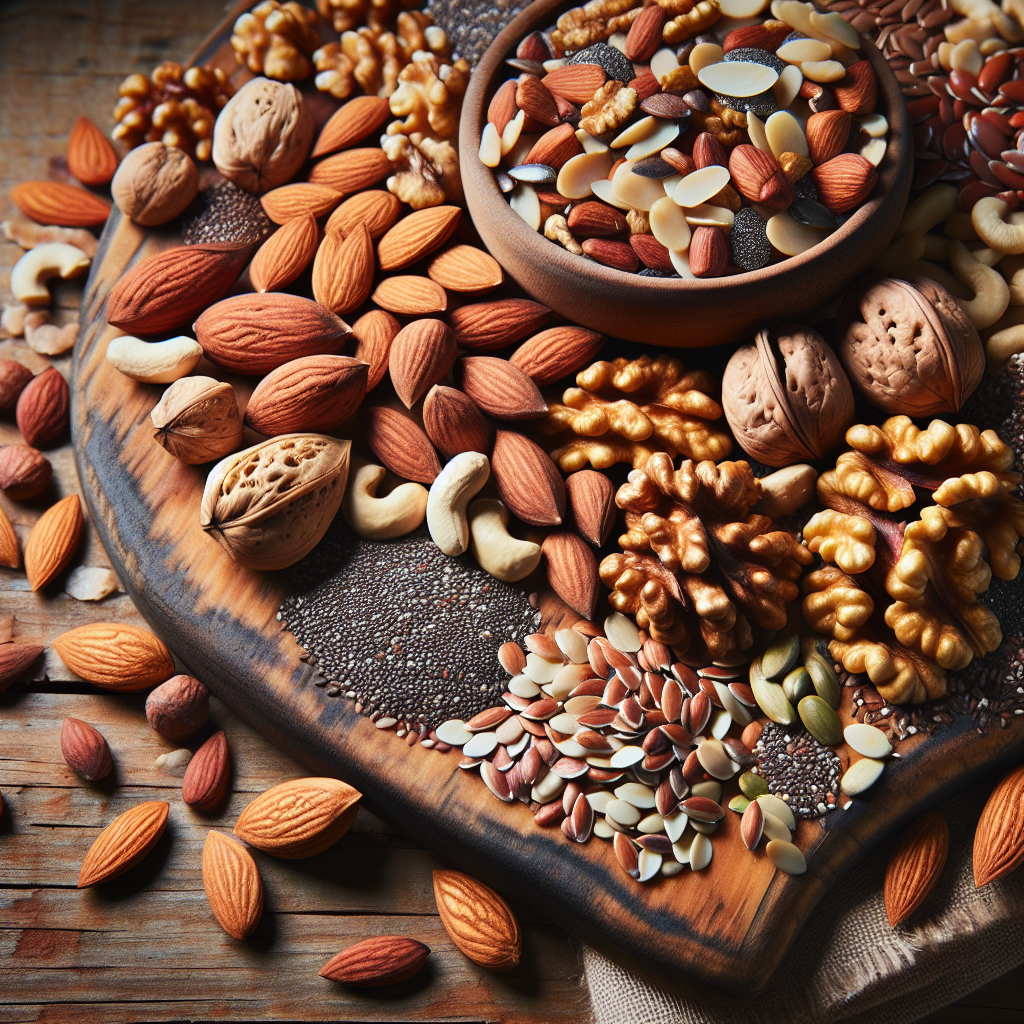Indulge in a culinary adventure with Tastepan’s collection of nutritious and delicious recipes. We believe that prioritizing your well-being doesn’t mean compromising on taste. In our latest article, “Cooking With Nuts And Seeds: Nutrient-Dense Options,” we explore the world of nuts and seeds, uncovering their incredible health benefits and sharing creative ways to incorporate them into your meals. Get ready to nourish your body while tantalizing your taste buds, because healthy eating has never been this flavorful!

The Benefits of Cooking with Nuts and Seeds
Cooking with nuts and seeds can be a delicious way to boost the nutrient content of your meals. Not only do they add texture and flavor, but they also provide a range of health benefits. From increased nutrient intake to heart-healthy fats and plant-based protein, nuts and seeds are a valuable addition to any kitchen.
Increased Nutrient Intake
One of the main benefits of cooking with nuts and seeds is that they are nutrient-dense options. They are packed with essential vitamins, minerals, and antioxidants that can contribute to a well-balanced diet. By incorporating these ingredients into your meals, you can increase your overall nutrient intake and support your overall health.
Heart-Healthy Fats
Nuts and seeds are rich in heart-healthy fats, such as monounsaturated and polyunsaturated fats. These fats have been shown to lower bad cholesterol levels and reduce the risk of heart disease. By using nuts and seeds in your cooking, you can improve the nutritional profile of your dishes and prioritize your heart health.
Plant-Based Protein
For individuals following a plant-based diet, nuts and seeds can be a great source of protein. They contain all the essential amino acids your body needs and can help meet your daily protein requirements. Incorporating these ingredients into your meals can provide the necessary protein for building and repairing tissues, and supporting overall health.
Fiber-Rich Options
Nuts and seeds are also excellent sources of dietary fiber. Fiber is important for maintaining healthy digestion and promoting feelings of fullness. By including these ingredients in your cooking, you can increase your fiber intake and support a healthy digestive system. Plus, fiber can help regulate blood sugar levels and promote weight management.
Essential Nutrients Found in Nuts and Seeds
When it comes to nutrients, nuts and seeds are packed with essential vitamins, minerals, and antioxidants that are beneficial for your overall health. Let’s take a closer look at some of the key nutrients found in these ingredients.
Omega-3 Fatty Acids
Certain nuts and seeds, such as walnuts and flaxseeds, are rich in omega-3 fatty acids. These healthy fats are known for their anti-inflammatory properties and can help support brain health, heart health, and overall well-being. By incorporating omega-3-rich nuts and seeds into your cooking, you can reap the benefits of these essential fatty acids.
Vitamin E
Nuts and seeds are also excellent sources of vitamin E, a powerful antioxidant that helps protect your cells from damage caused by free radicals. Vitamin E is important for maintaining healthy skin, hair, and nails, as well as supporting your immune system. Including nuts and seeds in your meals can help boost your vitamin E intake and support your overall health.
B Vitamins
Many nuts and seeds are rich in B vitamins, including thiamin, riboflavin, niacin, and folate. These vitamins play a crucial role in maintaining a healthy metabolism and supporting the production of energy in your body. By cooking with nuts and seeds, you can increase your intake of these essential B vitamins and support your overall well-being.
Minerals: Magnesium, Zinc, and Iron
Nuts and seeds are also abundant in important minerals such as magnesium, zinc, and iron. Magnesium is essential for maintaining healthy nerve and muscle function, while zinc is important for immune system support and wound healing. Iron is crucial for the production of red blood cells and the prevention of iron deficiency anemia. By incorporating nuts and seeds into your cooking, you can boost your intake of these vital minerals and support your overall health.

Different Types of Nuts and Their Nutritional Profiles
There are various types of nuts, each with their own unique nutritional profiles. Let’s explore a few popular nuts and the benefits they offer.
Almonds
Almonds are known for their crunchy texture and delicate flavor. They are a great source of healthy fats, protein, fiber, and vitamin E. Almonds also contain calcium and magnesium, which are essential for strong bones and teeth. Including almonds in your cooking can provide numerous health benefits and add a delightful crunch to your meals.
Walnuts
Walnuts have a distinct earthy flavor and are rich in omega-3 fatty acids. They are also a good source of protein, fiber, and B vitamins. Walnuts have been associated with various health benefits, including improved brain health and reduced inflammation. Adding walnuts to your recipes can bring a unique flavor and boost your nutritional intake.
Cashews
Cashews have a creamy and buttery taste, making them a versatile ingredient in cooking. They are a good source of healthy fats, protein, and minerals such as magnesium, zinc, and iron. Cashews have been linked to improved heart health, weight management, and bone health. Incorporating cashews into your meals adds a delightful creaminess and nutritional value.
Pistachios
Pistachios are small, vibrant green nuts with a slightly sweet and nutty flavor. They are an excellent source of protein, fiber, and healthy fats. Pistachios also provide a variety of vitamins and minerals, including vitamin B6, copper, and potassium. These nuts have been associated with weight management, heart health, and improved blood sugar control. Adding pistachios to your dishes can bring a burst of color, taste, and nutritional benefits.
Peanuts
Peanuts are technically legumes, but they are often grouped with nuts due to their similar characteristics. They have a distinct nutty flavor and are packed with protein, fiber, and healthy fats. Peanuts are a rich source of niacin, folate, and vitamin E. They have been associated with heart health, blood sugar control, and weight management. Incorporating peanuts into your cooking can add a nutty and satisfying element to your meals.
Pecans
Pecans have a sweet and buttery flavor and are commonly used in baking and desserts. They are a great source of healthy fats, fiber, and antioxidants. Pecans also provide various minerals such as magnesium and zinc. These nuts have been linked to heart health, brain health, and improved digestion. Including pecans in your recipes can add a rich flavor profile and enhance the nutritional value of your dishes.
Exploring Various Seeds and Their Health Benefits
Seeds are another great addition to your cooking repertoire. They are packed with essential nutrients and can provide a range of health benefits. Let’s explore some popular seeds and the benefits they offer.
Chia Seeds
Chia seeds have gained popularity in recent years due to their numerous health benefits. They are an excellent source of omega-3 fatty acids, fiber, and antioxidants. Chia seeds are also rich in calcium, magnesium, and phosphorus, which are important for bone health. These tiny seeds have been associated with improved digestion, weight loss, and reduced inflammation. Adding chia seeds to your recipes can provide a nutritional boost and add a delightful crunch.
Flaxseeds
Flaxseeds are renowned for their high omega-3 fatty acid content and lignans, which are phytochemicals with antioxidant properties. They are also a great source of fiber, protein, and minerals such as magnesium and manganese. Flaxseeds have been linked to heart health, reduced inflammation, and improved digestive health. Incorporating flaxseeds into your cooking can add a nutty flavor and provide numerous health benefits.
Sesame Seeds
Sesame seeds are a staple in many cuisines worldwide and are known for their nutty flavor and delicate crunch. They are a good source of protein, healthy fats, and minerals such as calcium, iron, and zinc. Sesame seeds also contain lignans, which are beneficial for heart health and hormone balance. These seeds have been associated with improved bone health, cholesterol management, and reduced blood pressure. Adding sesame seeds to your dishes can bring a rich flavor and enhance the nutritional value of your meals.
Sunflower Seeds
Sunflower seeds are a popular snack option and a versatile ingredient in cooking. They are a good source of protein, healthy fats, and vitamins such as vitamin E and B vitamins. Sunflower seeds also provide minerals like magnesium, copper, and selenium. These seeds have been linked to improved heart health, reduced inflammation, and enhanced skin health. Incorporating sunflower seeds into your recipes can add a delightful crunch and provide a range of health benefits.

Incorporating Nuts and Seeds into Breakfast Recipes
Breakfast is the most important meal of the day, and incorporating nuts and seeds can make it even more nutritious and delicious. Here are some breakfast recipe ideas that will help you kickstart your day with a nutrient-packed meal.
Nutty Granola
Make a homemade granola packed with your favorite nuts and seeds. Combine oats, almonds, walnuts, cashews, chia seeds, and flaxseeds with a touch of honey or maple syrup. Bake it in the oven until golden brown, and you’ll be left with a crunchy and nutritious granola that you can enjoy with yogurt or milk.
Chia Pudding with Almond Butter
Create a delicious and filling chia pudding by combining chia seeds, almond milk, and a dollop of almond butter. Let it sit overnight in the refrigerator, and in the morning, you’ll have a creamy and nutrient-rich pudding. Top it with fresh berries, nuts, and seeds for added flavor and crunch.
Seed and Nut Overnight Oats
Prepare a batch of overnight oats by combining rolled oats, your choice of milk, and a mixture of seeds and nuts such as sunflower seeds, pumpkin seeds, and chopped almonds. Let it soak in the refrigerator overnight, and in the morning, you’ll have a creamy and fiber-rich breakfast. Feel free to add sweeteners like honey or maple syrup, as well as fruits and spices for added flavor.
Adding Texture and Flavor with Nuts and Seeds in Salads and Snacks
Nuts and seeds can take your salads and snacks to the next level by adding a satisfying crunch and a burst of flavor. Here are some ideas to incorporate them into your salads and snack time.
Crunchy Nut Mix
Create a flavorful and crunchy nut mix by combining your favorite nuts such as almonds, cashews, and pistachios with some seeds like pumpkin seeds and sunflower seeds. You can toast them in the oven with a sprinkle of salt and spices of your choice. This nut mix can be a healthy and satisfying snack on its own or an excellent topping for salads.
Roasted Seed Salad
Enhance the texture and nutritional value of your salads by sprinkling them with roasted seeds. Toast a mixture of sesame seeds, sunflower seeds, and pumpkin seeds and add them to your favorite salad. The seeds provide a delicious crunch and a range of health benefits.
Seedy Quinoa Salad
Make a protein-packed and flavorful quinoa salad by incorporating a variety of seeds and nuts. Cook quinoa, and once it’s cooled, mix it with flaxseeds, chia seeds, diced almonds, and chopped pistachios. Add some vegetables, herbs, and a zesty dressing, and you’ll have a vibrant and nutritious salad that is both filling and delicious.
Vegan and Vegetarian Entrées with Nuts and Seeds
Nuts and seeds are excellent additions to vegan and vegetarian entrées, providing the necessary protein, healthy fats, and a depth of flavor. Here are some delicious recipe ideas for vegan and vegetarian meals.
Lentil Walnut Loaf
Combine cooked lentils, chopped walnuts, breadcrumbs, flaxseeds, and a variety of spices to create a hearty and flavorful lentil walnut loaf. Bake it until golden brown, and you’ll have a protein-rich and satisfying main course for your vegan or vegetarian dinner. Serve it with roasted vegetables and a tangy sauce for a complete meal.
Stuffed Peppers with Quinoa and Pecans
Make a nutritious and filling stuffed pepper dish by stuffing bell peppers with a mixture of cooked quinoa, chopped pecans, dried cranberries, and herbs. Bake until the peppers are tender and the filling is cooked through. These stuffed peppers are packed with plant-based protein, healthy fats, and a burst of flavors. It’s an excellent option for a vegan or vegetarian main course.
Cashew Cream Pasta
Create a creamy and indulgent pasta sauce without the use of dairy by making a cashew cream sauce. Soak cashews in water until softened, then blend them with garlic, nutritional yeast, and vegetable broth until smooth and creamy. Toss the sauce with your favorite cooked pasta and vegetables for a decadent and plant-based meal. The cashew cream adds richness and a boost of healthy fats to the dish.
Delicious Nut and Seed Desserts
Nuts and seeds can also be transformed into delicious desserts that not only satisfy your sweet tooth but also provide some nutritional benefits. Here are a few dessert ideas that incorporate nuts and seeds:
Classic Peanut Butter Cookies
Combine peanut butter, almond flour, maple syrup, and a pinch of salt to create classic peanut butter cookies. These cookies are gluten-free, dairy-free, and refined sugar-free, making them a healthier alternative to traditional cookies. The peanut butter adds a nutty flavor and a dose of healthy fats to these sweet treats.
Coconut Chia Pudding with Mango
Create a tropical and refreshing chia pudding by combining chia seeds, coconut milk, and sweetening it with a touch of honey or maple syrup. Let it sit overnight in the refrigerator, and in the morning, top it with fresh mango slices and shredded coconut. This coconut chia pudding is not only delicious but also packed with fiber, healthy fats, and essential minerals.
Almond Flour Brownies
Make a decadent and gluten-free brownie by using almond flour as a substitute for traditional all-purpose flour. Almond flour adds a nutty flavor and a moist texture to the brownies, while also providing a good amount of protein and healthy fats. Enjoy these almond flour brownies as a guilt-free indulgence that satisfies your chocolate cravings.
Smart Substitutions: Using Nuts and Seeds in Place of Other Ingredients
Nuts and seeds can be used as smart substitutions for other ingredients, adding nutritional value and unique flavors to your dishes. Here are a few examples:
Nut Meals as Gluten-Free Alternatives
Instead of using traditional all-purpose flour, you can use nut meals such as almond meal or cashew meal as gluten-free alternatives in baking. Nut meals add a depth of flavor, moisture, and nutritional benefits to your baked goods. They can be used in a variety of recipes, including cakes, cookies, and crusts.
Seed Butter as a Peanut Butter Substitute
If you have a peanut allergy or prefer a different flavor, you can use seed butter, such as sunflower seed or pumpkin seed butter, as a substitute for peanut butter. Seed butter offers a similar creamy texture and richness, providing a delicious spread for sandwiches, toast, or as an ingredient in baking recipes. It’s also a great option for those following a paleo or nut-free diet.
Storage and Shelf Life: Tips to Keep Nuts and Seeds Fresh
To ensure that your nuts and seeds stay fresh and flavorful, it’s important to store them properly. Here are some tips for storage and maximizing their shelf life:
Proper Storage Containers
Transfer your nuts and seeds to airtight containers to protect them from moisture, light, and air. Glass jars or containers with good seals are ideal for storage. Label the containers with the contents and the date of purchase or expiration to keep track of their freshness.
Refrigeration vs. Room Temperature
While nuts and seeds can be stored at room temperature, refrigeration can help extend their shelf life. If you live in a warm and humid climate or if you’re not planning to consume them within a month, it’s best to store them in the refrigerator. However, be aware that refrigeration can sometimes cause the nuts and seeds to absorb odors from other foods, so consider using a separate container or section of your refrigerator for storage.
Checking for Rancidity
Over time, nuts and seeds can become rancid and develop an unpleasant taste. To check for freshness, give them a sniff – they should have a mild, nutty aroma. If they smell off or have a bitter taste, it’s a sign that they have gone rancid and should be discarded. It’s always good to buy in smaller quantities and replenish your stock regularly to ensure that you’re using fresh nuts and seeds in your cooking.
In conclusion, cooking with nuts and seeds offers a multitude of benefits. From increasing your nutrient intake to adding heart-healthy fats and plant-based protein, these ingredients are a valuable addition to any kitchen. Whether you’re looking to incorporate them into your breakfast recipes, salads, snacks, main courses, or desserts, the options are endless. With their unique flavors and abundant nutritional benefits, nuts and seeds can take your culinary creations to new heights. So, start exploring the world of cooking with nuts and seeds and enjoy the delicious and nutritious dishes you create.

